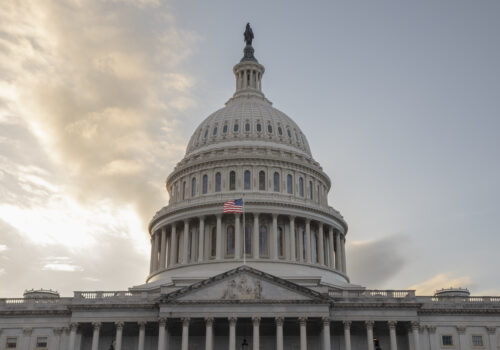For dollar-backed stablecoins to be truly stable, the US needs to set international standards
For all the debate about trade wars and flight away from the dollar in the aftermath of the April 2 “liberation day,” a more immediate challenge for many financial policymakers is actually a rush toward the dollar triggered by the global demand for dollar-backed stablecoins.
That’s why the world’s financial leaders are closely watching the debate playing out in Congress right now over the future of stablecoin legislation. Next week, the Senate will likely take up the GENIUS Act, which will define the responsibilities for US stablecoin issuers and clarify who is responsible for oversight.
Stablecoins are cryptocurrencies whose values are pegged to a specific underlying asset. This makes them “stable”—at least in theory.
Currently, 98 percent of stablecoins are pegged to the US dollar, but over 80 percent of stablecoin transactions happen outside the United States.
Countries around the world are taking notice. In April, Italy’s finance minister, Giancarlo Giorgetti, said that new US policies on dollar-backed stablecoins present an “even more dangerous” threat to European financial stability than tariffs. His argument was that access to dollars without needing a US bank account would be attractive to millions of people and could undermine the effectiveness of monetary policy not just in Europe but around the world.
In many ways, it’s an old problem with new technology. Dollarization—the situation where citizens in another country try to swap their local currency for dollars—has been a risk in emerging markets and developing economies for decades. In the early 2000s, for example, a range of countries from Ecuador to Zimbabwe to Argentina had difficulty managing the demand for dollars instead of local currency. In each situation, years of economic pain followed in these countries.
Now stablecoins are making it cheaper and easier for people around the globe to get ahold of what is still the single most in-demand asset in the world.
Now stablecoins are making it cheaper and easier for people around the globe to get ahold of what is still the single most in-demand asset in the world.
Instead of the old way of having to go to a bank and exchange local currency for US dollars, which is time consuming and often involves significant fees, stablecoins make dollars seamlessly available to anyone with a cell phone.
US officials argue that this benefits the United States. When I interviewed Federal Reserve Governor Christopher Waller, who oversees payments at the central bank, about this issue in February, he said that stablecoins “could be in any fiat currency,” such as pounds or euros, “but everyone wants dollar-denominated stablecoins.” He added that “if we can get good regulation, allow these things to go out, this will only strength the dollar as a reserve currency.”
Waller’s point was that if stablecoin issuers need to back up their coins with Treasuries or other liquid assets, the increase in stablecoin usage around the world will generate even higher demand for dollars. The whole point of a stablecoin is that you can fully convert it into a dollar if you want to—meaning the issuers need to have those dollars on hand.
US Treasury Secretary Scott Bessent has put it even more bluntly. “We are going to keep the US the dominant reserve currency in the world, and we will use stablecoins to do that,” he said in March.
If so, the United States should tread cautiously.
The global proliferation of stablecoins means that some companies will take advantage of the demand and issue stablecoins that claim they are digital versions of the dollar but in reality aren’t fully backed by dollars.
If that company failed, it wouldn’t just cost consumers their savings. It could trigger a run on all kinds of financial assets.
Think back to the collapse of the algorithmic stablecoin TerraLuna in 2022. Over $45 billion in value for TerraLuna holders was wiped out within a week. But since that time, stablecoin volumes have increased across the world by over 60 percent.
The current patchwork of regulations around the globe creates more confusion, more friction in payments, and ultimately higher costs for consumers.
Already, that’s what’s happening. As new research from the Atlantic Council GeoEconomics Center shows, some countries want to create their own central bank digital currencies to compete with stablecoins, while other countries are trying to regulate the wallets that hold stablecoins.
Instead of waiting for new regulatory fences to be built up in the coming years, the United States should show that it recognizes the concerns other countries have about dollar-backed stablecoins. The legislation in front of Congress helps domestically by creating transparency and reporting requirements, but it does little internationally.
This is where the Group of Twenty (G20) comes in. The United States has a golden opportunity to help set international standards around digital assets, including the risks and regulations associated with stablecoins, during its G20 presidency next year. A key first step would be creating a new G20 payments roadmap.
A first roadmap was agreed to in 2020 and delivered important innovations on faster payments. But technology has rapidly changed in the past five years, and it’s time for an upgrade.
If the United States made stablecoins a focus this year, it would raise the bar across the world and ensure that dollar-backed stablecoin users in all countries are getting what they bargain for—an actual dollar—instead of an imitation of one.
The rest of the world will welcome US leadership in this space and will take it as a sign that, at least when it comes to the future of the dollar, the United States is not looking to export instability.
Josh Lipsky is the chair of international economics at the Atlantic Council and senior director of the Atlantic Council’s GeoEconomics Center.
Further reading
Fri, Apr 18, 2025
Stablecoin regulation is pending in Congress. Here are six ways the proposals should be improved.
New Atlanticist By
The two stablecoin bills under consideration in Congress create helpful guardrails, but need improvements in order to establish an effective regulatory regime.
Wed, Feb 12, 2025
Central bank digital currencies versus stablecoins: Divergent EU and US perspectives
Econographics By Barbara C. Matthews, Hung Tran
All policymakers agree on one point: both CBDCs and stablecoins will significantly impact the global role of the US dollar.
Thu, May 22, 2025
Gold’s geopolitical comeback: How physical and digital gold can be used to evade US sanctions
New Atlanticist By Kimberly Donovan, Maia Nikoladze
The rise of gold-backed currencies that circumvent the US banking system could create a massive blind spot for US sanctions enforcement efforts.
Image: Die Logos der Kryptow‰hrungen Bitcoin BTC, Ethereum ETH, des Stablecoins Tether USDT, Binance Coin BNB und Solana SOL sind auf der Handelsplattform CoinMarcetCap zu sehen. Aufnahme mit l‰ngerer Belichtungszeit. Rottweil Baden-W¸rttemberg Deutschland *** The logos of the cryptocurrencies Bitcoin BTC , Ethereum ETH , the stablecoin Tether USDT , Binance Coin BNB and Solana SOL can be seen on the trading platform CoinMarcetCap Photo with longer exposure time Rottweil Baden W¸rttemberg Germany REUTERS



